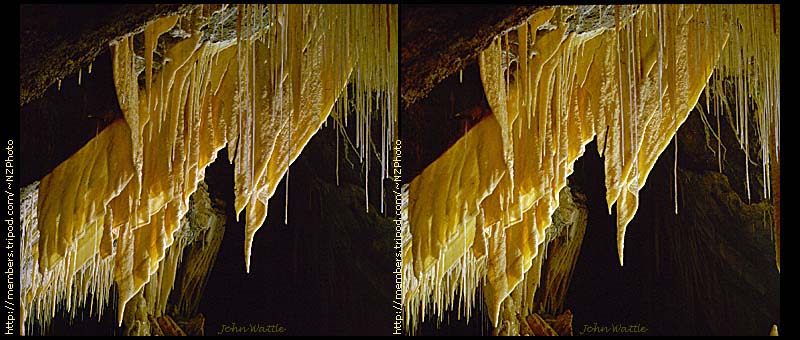Stereoscopic Cave PhotographyPhotographing in the dark by painting with lightJohn Wattie |
Contents: |
Images: |
Painting with lightKomrad is a "wild cave", not a
commercial cave. It is not easily found unless you join a speleological society trip. It
is near Waitomo, in New Zealand. Illumination is not electric lights, as there is no power
in this remote place. |
HyperstereoscopyThe two-camera method has introduced slight errors. The colour balance is not the same (since the films were different batches and the 50mm lenses were not identical - one was an Exacta and the other a Nikon.) This has not quite been corrected in PhotoShop. The cameras were not quite on the same horizontal line, but that does not cause much trouble - the human brain is amazingly tolerant of small errors. The 3D is enhanced because the cameras were further apart than human eyes. This is called hyperstereoscopy. A strange illusion shows up in hyperstereoscopy, called the model effect. Because the viewer seems to have eyes much further apart than normal, it is as if he/she were a giant. We do not think of ourselves as giants and get an impression the 3D objects are smaller than normal. Since you have no idea how big this cave was, the fact it looks only about 1/2 normal size is no problem. |
|
||
|
Taumatamaire Cave Passage in X Stereo Taumatamaire Cave Passage in X Stereo
|
|
Taumatamaire cave passage in anaglyph format. This requires red / blue-green glasses: Left eye red, Right eye blue-green.
|
|
Further mystery is seen in the
Taumatamaire picture
because the text "X Stereo" and the photographer's name seem to lie inside the
rocks. This stereoscopic illusion only works with black rocks. Rocks whose surface is lit by the flashgun become very confused if something is inside them. The brain will not accept it, since this is contrary to normal experience (unless you are Superman, with Xray vision of course). |
 |
|
Komrad Cave in X Stereo Komrad Cave in X Stereo |
  |
||||
|
Komrad Cave in U Stereo Komrad Cave in U Stereo
Use the two middle pictures. (Pan right first, if you have to). If the separation is too great for your eyes, move back from the screen. |
Escape from 3D: New Zealand Images
![]()
More macro stereo and cave stereo photography (from
Australia)
at David Stuckey's Site:
http://www.acay.com.au/~dstuckey/framesetf.html